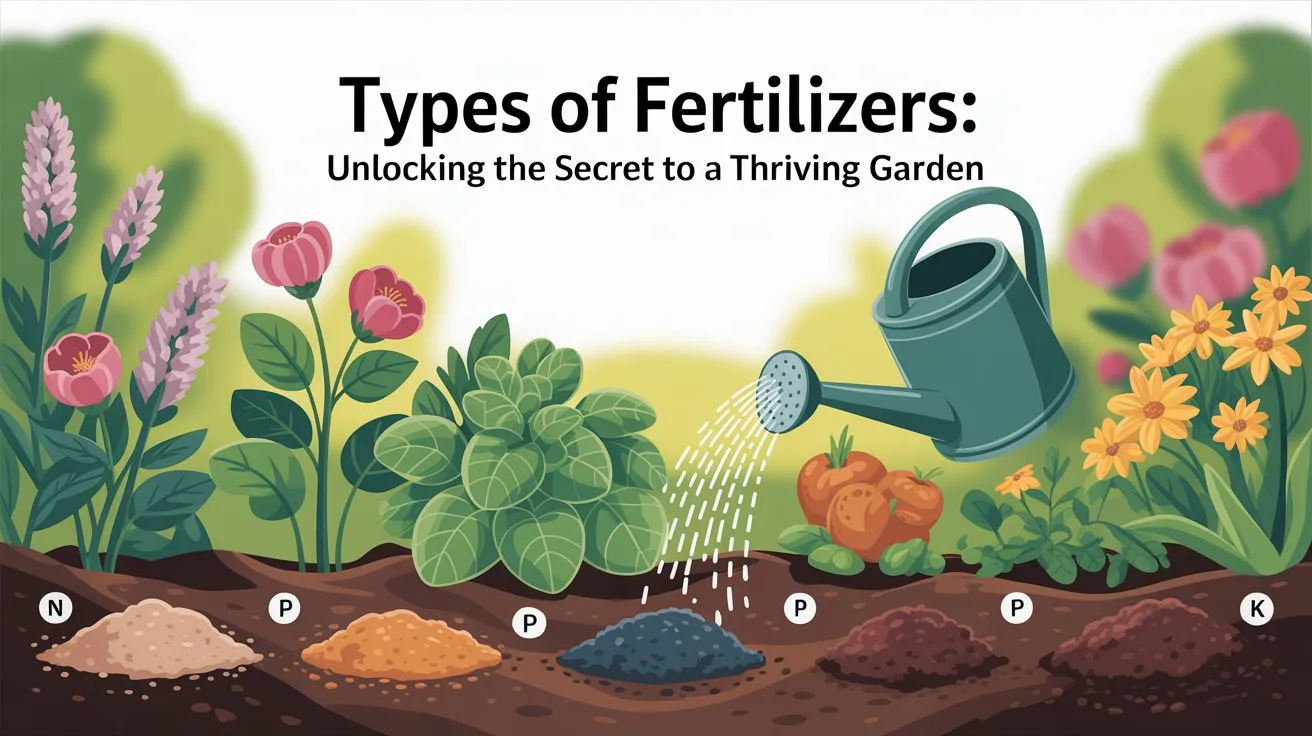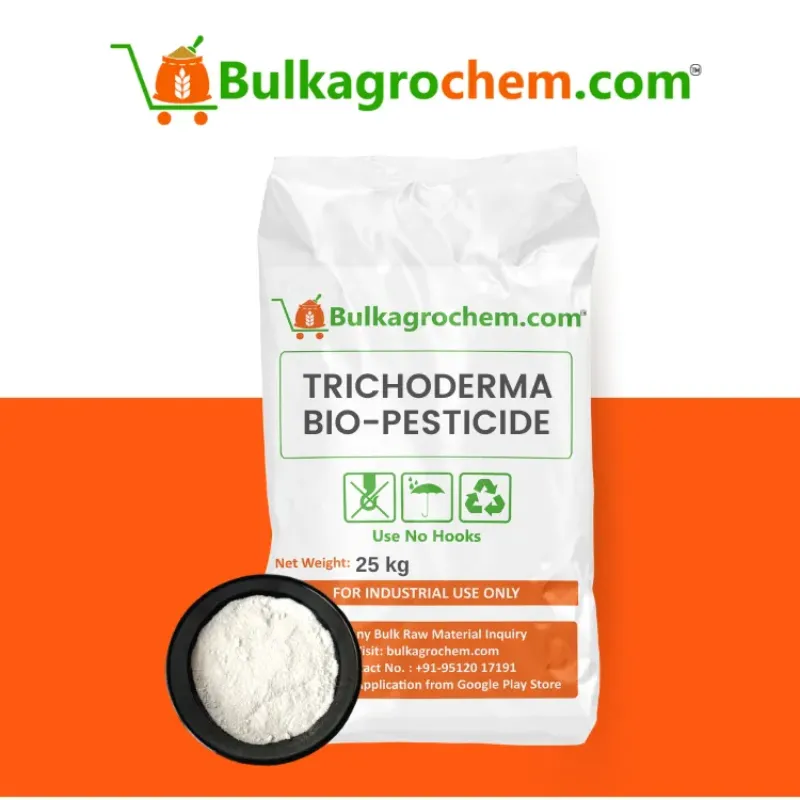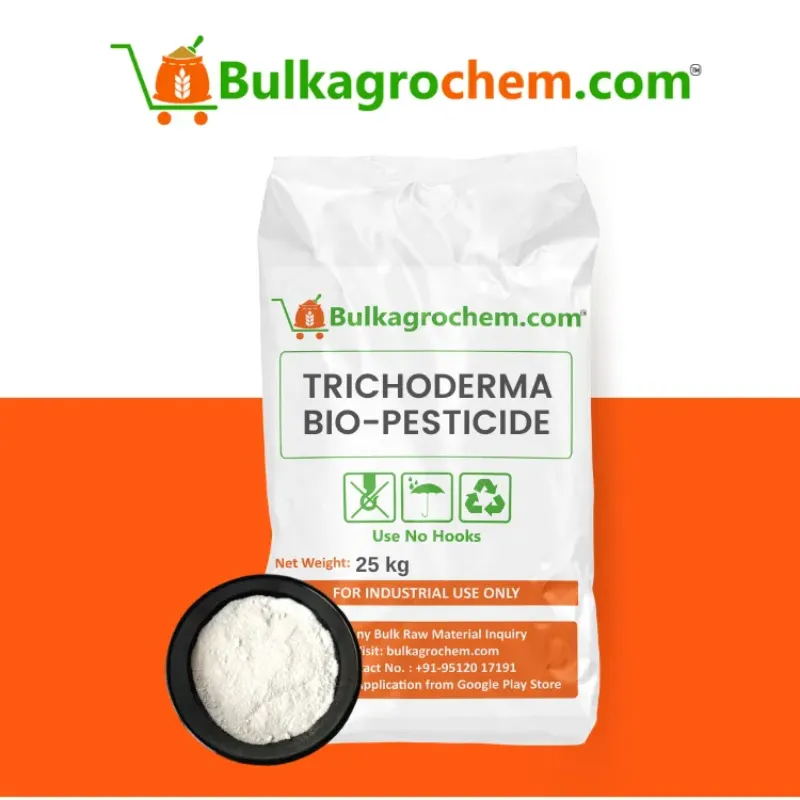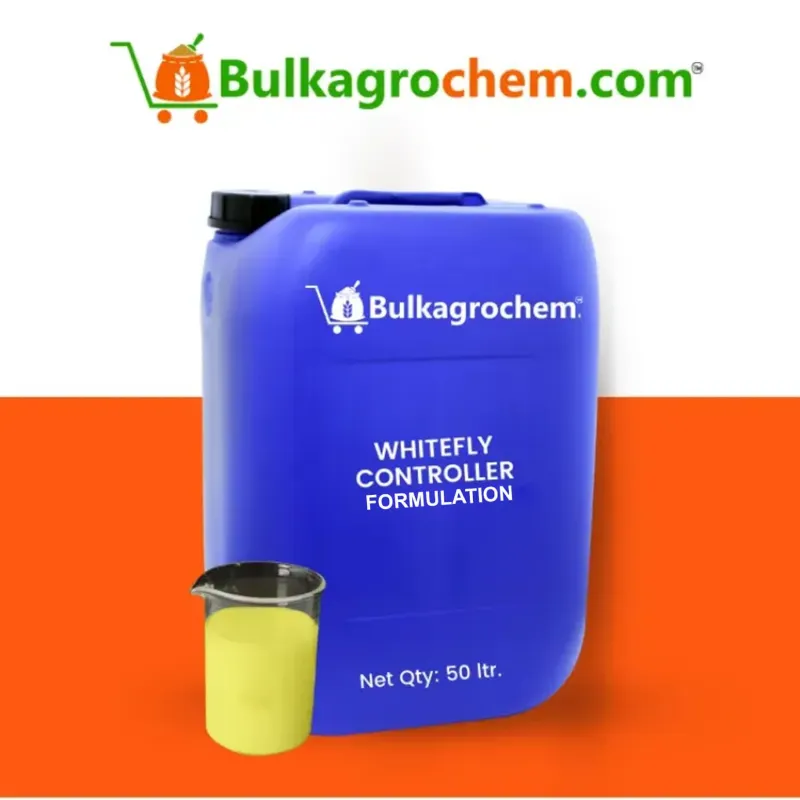Fertilizers are critical in supplying the essential nutrients necessary for trying to get large, healthy plants to grow. fertilizers will have many options for plants.
Fertilizers would depend on what the plant required and the condition of soil. There are several things one can buy for gardeners or farmers.
Organic fertilizers are compost, manure and other plant by-products. Organic fertilizers will always improve soil structure and increase soil health for your long-term benefit.
Chemical or synthetic fertilizers are specifically made to provide specific nutrients, with the requirement of providing the nutrients to plants quickly. This is also the reason that synthetic fertilizers come primarily as NPK blends. (N-Nitrogen, P-Phosphorus, K-Potassium combinations). NPK combinations are important for the quick growth of plants.
Biofertilizers contain living organisms, either in bacteria or fungi that can naturally improve nutrient availability and soil fertility.
In modern day gardening, people have even discovered that there are liquid fertilizers, granular fertilizers, and slow-release fertilizers. From these options there is a lot of flexibility to provide nutrients for plants at any stage of their growth.
Introduction: Why Choosing the Right Fertilizer is Crucial for Your Plants
Like any living organism, plants need adequate nutrition to grow successfully. Fertilizers are important forms for providing nutrients that may be absent in the soil, emphasizing healthy, growing plants.
Through the various types of fertilizers available, gardeners and farmers can provide nutrition that meets more specific plant needs. Correct fertilizer selection can help plants grow a little faster, yield more flowers or fruits, and generally resist disease better.
Importance of fertilizers for healthy plant growth:
Fertilizers are critical in making sure that plants obtain the necessary nutrients for consistent and healthy growth. In many cases, garden soils may not include key components that are required for plant life. This is where the appropriate types of fertilizers can help to supply the right ratios of nutrients to plants for optimum growth. Without the proper nutrients in the soil, plants might experience slowed growth, yellowed foliage, weak stems and limited flowering or fruiting. Using the proper combination of the different types of fertilizer can ensure that plants obtain both macronutrients such as nitrogen, phosphorus and potassium along with key micronutrients such as iron, magnesium and zinc.
Typically the assumed benefits of fertilizers for plant growth would include the following benefits:
- Correctly correcting nutrient deficiencies in the soil.
- Create well-developed root systems and lush foliage.
- Create fuller blooms and increase fruiting.
- Help plants to become resistant to disease and environmental stresses.
- To increase soil fertility in combination with a program that includes all types of fertilizer.
The role of plant nutrition in garden success:
Plant nutrition is the basis for any good garden. Each plant depends on a constant supply of nutrients for photosynthesis, root growth and flowers. The proper use of different fertilizers will assist in creating a balanced soil environment to ensure plant health in the short-term and soil health in the long-term.
Gardeners who are aware of all fertilizer types — organic, synthetic, bio-fertilizers, or specialty fertilizers — can match their fertilization strategy to their own soil conditions and the needs of the plant.
- Provides uninterrupted growth at every stage of the lifecycle of the plant.
- Helps ensure efficient use of water and uptake of nutrients.
- Works with beneficial soil organisms that help promote healthier soil structure.
- Enables fertilizer plans to be tailored using several different fertilizers depending on plant species and seasonal growth.
Chemical Fertilizers: Understanding Different Types of Fertilizer
Chemical fertilizers, or synthetic fertilizers, are human-made formulas used to quickly provide essential macro and/or micro-nutrients for plants. They are widely used by producers and home gardeners due to their speed and targeted outputs. All chemical fertilizer contains concentrated nutrients such as nitrogen, phosphorus, and potassium (NPK) or other nutrients like calcium and magnesium which are present at quantifiable ratios depending on plant's use. Chemical fertilizers are one of the many types of fertilizer available, and they encourage plants to respond quickly when they experience deficiencies.
What Are Chemical and Synthetic Fertilizers?
Chemical or synthetic fertilizer is a man made product specifically made with concentrated nutrients to provide nutrient access directly to plants. They are highly effective fertilizers because they allow fast nutrient availability to the plant and are able to produce quick plant responses.
Chemical and synthetic fertilizers are manufactured through industrial processes where essential nutrients such as nitrogen, phosphorus and potassium (NPK) and other micronutrients are supplied in accurate proportions. Chemical or synthetic fertilizers are widely used for commercial and residential farming and home gardens because of their immediate availability.
- Key Features of Chemical and Synthetic Fertilizer
- Manufactured through chemical processes
- Provide instant nutrients availability
- Offered in several different forms such as granules, liquid, powder, and pellets
- Used in all fertilizer formulations to give the plant additional energy for rapid growth.
Benefits of Chemical Fertilizers in All Types of Fertilizer
Chemical fertilizers have multiple benefits that are essential in modern gardening and farming. They are often used with varying types of fertilizer in nutrient management plans.
Benefits:
- Provide the specific ratios needed by plants.
- Quickly correct nutrient deficiencies.
- Simple to store and apply.
- Easily bought and inexpensive at scales meaningful for commercial agriculture.
- Supplements other fertilizers to meet the immediate nutrient demands.
Drawbacks of Chemical Fertilizers Compared to Different Fertilizers
While chemical fertilizers can definitely be useful, there are drawbacks, some more offensive than others and related to overuse or inappropriate use. This is the time when it becomes necessary to be aware of balancing all types of fertilizer choices.
Main Disadvantages:
- Overuse can cause nutrients to run off and invade our water places.
- May fragment soil structure over time and kill good soil microbes.
- Can cause salt buildup in the soil, reducing the plants that can survive.
- Are unable to deliver the organic matter that allows most fertilizers to enhance soil in the long term.
Organic Fertilizers: Nurture Your Soil Naturally
Organic fertilizers come from naturally occurring plant, animal, or mineral sources. In contrast to chemical fertilizers, they can provide nutrients for plants, build soil structure, and promote beneficial microorganisms. Most forms of fertilizers are organic fertilizers because they provide plant support as well as long-term soil health.
The different types of fertilizer biodegrade at different rates, but all ultimately release nutrients over time as the soil microbes break down the natural material, creating a healthy long-term growing environment.
What Are Organic Fertilizers? (Part of All Types of Fertilizer)
Organic fertilizers are made from natural materials derived from plant, animal, or mineral sources. They are an important part of all types of fertilizer options because they feed plants while improving overall soil health. Unlike synthetic options, organic fertilizers work gradually, enriching the soil with nutrients over time as they break down.
Among the different types of fertilizer, organic fertilizers support both immediate plant growth and long-term soil fertility, making them highly valued in sustainable gardening and farming practices.
Common Organic Fertilizer Sources:
- Compost (kitchen scraps, yard waste)
- Animal manure (cow, poultry, sheep)
- Bone meal, blood meal, and fish emulsion
- Seaweed and rock minerals
Benefits of Organic Fertilizers Among Different Types of Fertilizer:
Organic fertilizers offer several unique advantages that make them an essential part of modern nutrient management, especially when combined with different fertilizers.
Key Benefits:
- Improve soil structure and increase organic matter content.
- Encourage microbial activity, which enhances nutrient availability.
- Reduce the risk of nutrient leaching and water pollution.
- Provide slow, steady nutrient release.
- Promote healthier and more resilient plants.
- Work well when used alongside other types of fertilizers for a complete soil care strategy.
Limitations Compared to Other Different Fertilizers:
While organic fertilizers bring many advantages, they also have certain limitations, especially when compared to fast-acting synthetic options within all types of fertilizer categories.
Key Limitations:
- Nutrient content is lower and less predictable.
- May require larger application amounts.
- Nutrients become available more slowly, which might not meet immediate plant needs.
- Some organic materials may carry weed seeds or pathogens if not properly processed.
- Often more labor-intensive to apply compared to some different types of fertilizer.
Biofertilizers: A Sustainable Option Among All Types of Fertilizer
Biofertilizers are natural solutions based on living microorganisms that improve soil fertility. Biofertilizers provide the same benefits as synthetic inputs or naturally occurring organic inputs but in terms of biological activity/additive capability/benefit (decomposition/increased nutrient supply). They will play an essential role in any type of fertilizer product available for environmentally friendly sustainable agricultural practices. These types of fertilizers maintain natural cycling and availability of nutrients to soil, reduce the need for chemical fertilizers, and ensure long term productivity of the soil.
How Biofertilizers Work in the Soil
Biofertilizers differ from the other forms of fertilizers in that they are living microorganisms that enhance the natural fertility of the soil. Other chemical and organic fertilizers simply add chemicals to the soil or plant. Biofertilizers, however, add beneficial bacteria, fungi and algae to the soil that work in conjunction with the plant to provide it with the nutrients and mineral elements required for growth, and root support.
When compared to all of the other types of fertilizer, biofertilizers are unique in that they introduce microbes to soil, which establishes a microbes population while optimizing the use of synthetic inputs (chemicals).
Biofertilizers benefit plants by:
- Converting atmospheric nitrogen into plant-usable forms.
- Solubilizing phosphorus into a form that plants can uptake easier to the roots.
- Enhancing root growth by creating natural plant hormones such as auxins and gibberellins.
- Improves soil aggregate and soil structure by adding organic matter and microorganisms that add to the microbial diversity in the soil.
Biofertilizers vs Different Fertilizers for Eco-Friendly Growth
Overall, biofertilizers are an environmentally sustainable alternative to conventional fertilizers when caring for plants, promote less reliance on fertilizers and provide some long-term viability for the soil. This document outlines the several environmental advantages of using biofertilizers:
- Reduce pollution in the environment, and leaching of nutrients.
- Using biofertilizers takes less energy to produce than conventional fertilizers.
- Promote soil fertility without harming existing beneficial organisms in the soil.
- Reduce the risk of over-fertilizing and or causing an imbalance of nutrients in the soil.
- Biofertilizers can be coupled to conventional fertilizers in an integrated nutrient management approach for example.
Common Biofertilizer Products
The biofertilizers are many and manufactured with specific nutrient needs in mind, based on crop and soil type. Biofertilizers are most often used with various fertilizer options to form a complete fertilization program.
Common Biofertilizers:
- Rhizobium – Nitrogen fixation for leguminous crops.
- Azospirillum - Nitrogen supply for cereals and grasses
- Azotobacter - Increases nitrogen availability in non-leguminous plants
- Phosphate Solubilizing Bacteria (PSB) - Increases phosphorus availability
- Mycorrhizal fungi – Increase nutrient acquisition by the roots and water uptake.
Specialty Fertilizers: Tailoring Nutrition for Different Fertilizers Needs
Specialty fertilizers are designed to meet specific nutritional needs of individual plants, soil types , and climates, and to assist farmers and gardeners looking for more advanced feeding programs beyond the options provided by the many categories of fertilizers available in the marketplace today. With great science and accuracy, specialty fertilizers, as the name portion implies, claim to provide optimum growth of plants.
By understanding your fertilizer types, growers can maximize the use of specialty fertilizers while ensuring efficacious use and minimal waste.
Customized Fertilization for Different Types of Fertilizer Needs
All plants have specific nutrient requirements, and custom fertilization can support those specifications. One of the advantages of the variety of fertilizer applications is the creation of custom blends that allow growers to optimize the nutrients needed based on soil conditions, crops, and growth stages. This is a common approach that is being utilized by both the home gardener and the commercial grower.
Customizing fertilization input by blending fertilizer types provides a balanced approach that promotes good plant health and reduces nutrient waste.
Benefits of customized fertilization:
- Creates nutrient formulations that specifically suit particular crops and soil tests.
- Provides remedies for macro- and micronutrient deficiencies.
- Mitigates the chance of over-or under-fertilizing.
- Utilizes various fertilizer components for results that are balanced, short and long-term.
Slow-Release Fertilizers in All Type of Fertilizer Solutions
Slow-release fertilizers are one aspect of fertilizer strategies for all types of plants due to their gradual release of nutrients over time. This convenient nutrient supply allows the plant to absorb the nutrients in cooperation with metabolic needs, reduces leaching chance, and makes for greater nutrient use efficiency.
Among the range of fertilizers available, slow-release options are often the choice when concerned with, for example, ornamental gardens, lawns and long-season crops that are going to need a consistent supply of nutrients.
Benefits of Slow-Release Fertilizers:
- Sustained nutrient supply for weeks to months.
- Fertilizer no longer must be applied as often.
- Decreases loss of nutrients from leaching or volatilization.
- Effective alongside other fertilizers as a strategy for maintaining soil fertility over time.
Liquid Fertilizers vs Other Different Fertilizer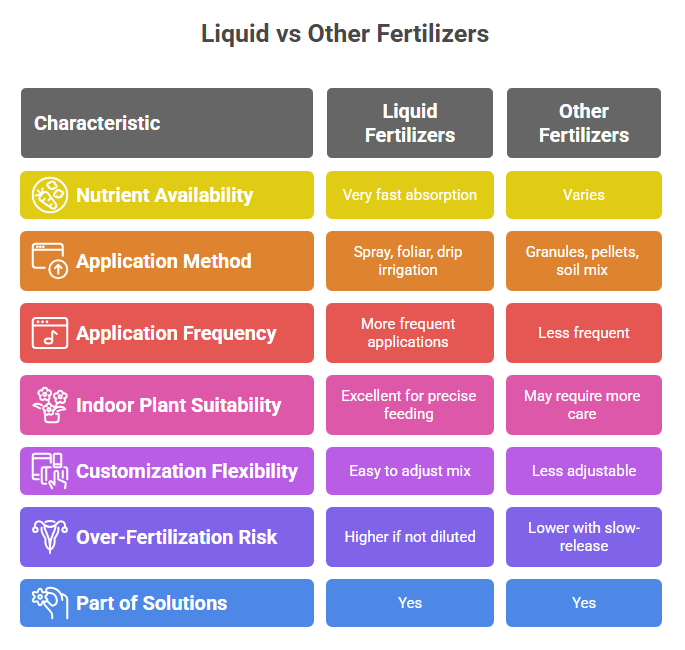 How to Choose Among Different Types of Fertilizer for Your Garden
How to Choose Among Different Types of Fertilizer for Your Garden
Choosing the proper fertilizer can impact your garden's success significantly. Each plant has its own unique requirements. Knowing the types of fertilizers available helps understand how to feed your plants. A thoughtful combination of all fertilizer types will allow your plants to thrive, while allowing your soils to remain healthy for future needs.
By understanding how fertilizers behave, you can develop a feeding plan that meets your garden's exact needs.
Fertilizer Selection Based on Soil Testing
Soil testing is the first critical step in selecting the right types of fertilizers for your plants. A proper soil test reveals existing nutrient levels, pH balance, and any deficiencies that need to be corrected. With this information, gardeners can choose the best combination of different fertilizers to meet their plants’ exact needs.
Using soil testing helps you avoid overuse and ensures the correct balance of nutrients from all types of fertilizer options.
Key Benefits of Soil Testing:
- Identifies nutrient deficiencies before they affect plant growth.
- Helps choose the right different types of fertilizer based on soil condition.
- Prevents over-fertilization and nutrient runoff.
- Supports efficient and cost-effective fertilization plans.
Choosing Different Fertilizers for Plant Growth Stages
Plants use different nutrients at different stages; using different fertilizers suited to each stage of growth is helpful to ensure plants receive what they need, when they need it. For example, young plants may be in need of additional nitrogen to produce leaf and stem growth while flowering or fruiting plants may need more phosphorus and potassium. If you choose the right types of fertilizers, depending on growth stage, you are maxi missing yields and plant health.
Fertilizer Needs by Growth Stage:
- Seedling Stage- High Nitrogen Fertilizers for root and leave development
- Flowering Stage- High phosphorus fertilizers to produce blooms
- Fruit/Bulb Development- High potassium fertilizers to enhance fruit quality
- Mix different fertilizers as plants transition from different growing stages.
Balancing All Type of Fertilizer for Long-Term Soil Health
Sustainable gardening and farming ask you to balance what the plants need today by considering what the soil requires for the long-term. To produce healthy plants with high nutrient values we can use all types of fertilizers in the right combinations that will help sustain soil fertility in the long-term, prevent nutrient depletion and support a healthy community of microbes.
There are many practical methods to achieve the long-term fertilizer balance which includes:
- Alternating between organic and chemical fertilizers to sustain balanced nutrient levels.
- Employing biofertilizers for enhancing soil biology.
- Regularly applying compost.
- Using slow-release fertilizers to ensure that you are receiving a consistent supply of nutrients over an extended period.
- Regular monitoring of soil health will help identify the appropriate fertilizers to apply as conditions change.
FAQs
Q1 What are the main types of fertilizers?
The main types of fertilizers include organic, chemical, biofertilizers, and specialty fertilizers.
Q2 Which type of fertilizer works best for beginners?
For beginners, balanced blends from different types of fertilizer like slow-release or organic options are easiest to manage.
Q3 Can I combine different fertilizers for better results?
Yes, combining different fertilizers can provide both immediate and long-term nutrition when used properly.
Q4 Are biofertilizers better than chemical fertilizers?
Biofertilizers are more eco-friendly but may be combined with chemical types of fertilizers for higher efficiency.
Q5 How often should I apply different types of fertilizer?
Application frequency depends on crop needs, but many different types of fertilizer are applied every 2-4 weeks during active growth.
Q5 What are the risks of using chemical fertilizers?
Overusing chemical fertilizers among all type of fertilizer options can harm soil health and pollute water sources.
Q6 Is liquid fertilizer part of all type of fertilizer options?
Yes, liquid fertilizer is one of the convenient choices within all type of fertilizer solutions for fast nutrient delivery.
Conclusion: Transform Your Garden with the Right Types of Fertilizers
Finding the right fertilizer is the key to a flourishing garden. With such a variety of fertilizer types, knowing your plant's nutrition requirements makes all the difference.
Just offering fertilizer and knowing it meets the plant's requirements isn't enough. By mixing fertilizers of various types like organic, chemical fertilizer, biofertilizers, specialty fertilizers, you will have created a nutrition plan catered to your edibles which engages the plant's use of the fertilizer to help it grow substantial root systems, develop proper vegetative growth for quality color, shape and produce heavy yields.
By offering the array of fertilizer options available it is possible to provide care for the soil today and invest in the care of the soil tomorrow and add resilience in future harvests whether it is vegetables, flowers or fruit trees and shrubs. A successful use of various fertilizers to suit the need of the edible and an aim to have them reach their potential will help the gardener maximize the crop aesthetic and embrace the full “bloom” of the edible garden.

